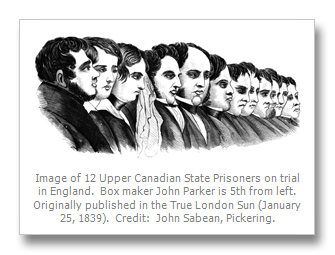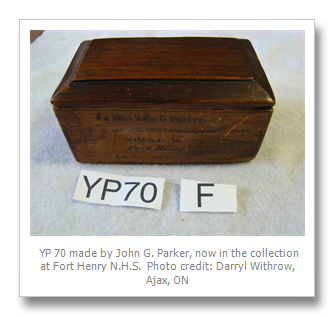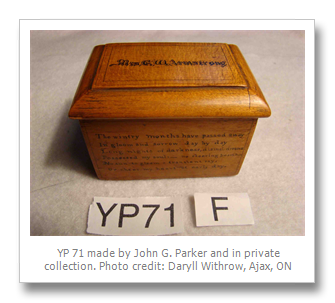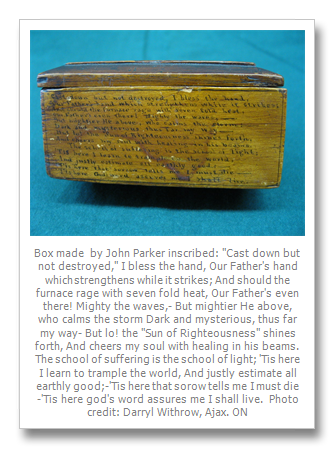2012 marks the 175th anniversary of the 1837/38 Upper Canadian Rebellions. This is a chapter in that story which has a Fort Henry connection.
Little boxes, little boxes: Tangible Evidence of the 1837 Upper Canadian Rebellion and the Fort Henry Connection
After defeat of rebel forces at Mongomery's Tavern on December 7, 1837, nearly 900 insurgents and alleged sympathizers were arrested for their involvement. More than half of these men were incarcerated in the Toronto Gaol. During months of imprisonment a number of these prisoners made little boxes from scraps of firewood. Although their shapes differ, most were rectangular and all had sliding, dovetailed lids. All were inscribed, many with the makers' names, most with the place and date of being jailed, and many with sentimental, religious or militantly political verses. Some were memorials to the executed rebel leaders Samuel Lount and Peter Matthews, while others had the names of persons to whom they were dedicated or given to.

Previously is had been thought that these prisoners' boxes were fashioned with pocket knives and pieces of glass. Recent research by Chris Raible, Darryl Withrow and myself has shown that this notion is highly questionable. Because of the technical nature of the construction of these boxes, they could not have been made by make-shift carving and rustic workmanship. Their creators would have had to be craftsmen who had access to and the use of superior hand tools such as saws, chisels and measuring devices to make these boxes.
This activity was engaged in by more than 50 men who most likely worked together in a co-operative enterprise to create these multiple boxes. nearly all the known boxes were made between April and late July of 1838. They were usually given to family members such as a wife or daughter or to sweethearts or admired neighbours or friends. It is not known exactly how many prisoners' boxes were made and distributed.
Jailed Toronto barrister Charles Durand noted in his memoires that; "Hundreds were sent out to friends." By 2009, 97 prisoners' boxes had been located in museum, municipal, library and archives holdings and in private collections. This inventory of existing prisoners' boxes with accompanying reflective essays, were published by the York Pioneer and Historical Society in a booklet entitled From Hands Now Striving to Be Free. Of the 97 prisoners' boxes identified and described in this publication, 93 were created at the Toronto Gaol and 4 were made at Fort Henry. Subsequent research and additional information coming from various period documents has increased this total number to 118 boxes. The most surprising fact is that at least 20 additional prisoners' boxes were created at Fort Henry!

The uncovering of details in primary research evidence confirms this exciting news. In June of 1840, Upper Canadian Patriot Benjamin Wait wrote to his wife Maria from the Ashgrove Estate near Oatlands in Van Diemen's Land (now Tasmania). He described his imprisonment at Fort Henry: "I find the society very agreeable indeed; and our time was not 'killed' as is usually the case with prisoners, nor spent in the games of chance, swearing, and lewd conversation, tall telling, &c. &c. But industry prevailed-all were engaged in something useful, ornamented or entertaining-some were reading, some writing; others were occupied in making port folios, small wooden boxes, or other mementoes for friendly presents." Wait as a prisoner awaiting transportation to the penal colony of Van Diemen's Land, provides solid, first-hand evidence of prisoners' boxes at Fort Henry.

Previously fellow prisoner John Tidey, a teacher and land surveyor from Norwich, Upper Canada, penned a May 5, 1839 entry in his diary. He noted that John G. Parker had been involved with box making and inscriptions while imprisoned at Fort Henry. Parker, who appears to be the most prolific box maker, was born in Winchester, New Hampshire. He eventually settled in Sacket's Harbour, New York. He then moved to Kingston in the mid 1830s to operate the steamship Kingston on the Bay of Quinte, and the steamship Perserverance on the Rideau Canal. He relocated to Hamilton in 1834 to conduct a wholesale business. He was arrested there on December 5, 1837. After his pardon he settled in Rochester, became a merchant and land owner. Subsequently he resided in Geneva and Brooklyn New York and in communities in New Jersey. He died in Rochester in 1875.

Parker had presented Fort Henry's master mason John Ogden with a box specifically made for him. This fact was identified in an official communique written by Major Richard W. Bonnycastle, who was in charge of engineers constructing Fort Henry. As senior officer there, he took command during the 1838 Upper Canadian rebellion. He wrote to his superior Colonel John Ross Wright in a official report about the end of July escape of 14 Patriot prisoners. Bonnycastle noted that Ogden had received a "Sympathy Snuff Box (so called), manufactured by him [Parker], with the Master Mason's name on it." Parker's journal confirmed that additional boxes had been made during incarceration at Fort Henry. He wrote to his wife recording that; "On Monday, 19th [November, 1838] we had our chains taken off, and I spent the day in writing several letters - one to Sheriff McDonnell [Allan Macdonell], requesting him to send you about twenty little boxes, made by the prisoners and which had been taken from me at Fort Henry." These boxes as well as a number of others left in the hands of John Tidey, were to be forwarded to Mrs. Parker but were never received by her. To this day the whereabouts of the majority of these prisoners' boxes remain a mystery.
With the passing of 175 years, rebellion prisoners' boxes have become prized by family relatives, collectors and museums. They remain as some of the few tangible pieces of evidence of the Upper Canadian Rebellion of 1837. As recent research proves, they have also become an important part of the history of Fort Henry.

Suggested Reading:
Richard H. Bonnycastle, "Escape of State Prisoners," Kingston, U.C. (July 30, 1838), Libray and Archives of Canada, C611, pp. 24-30.
Stephen B. Brophy, "Letter to the Editor," Watertown [New York]North American (August 7, 1838).
John C. Carter & Chris Raible, "Prisoners' Boxes: Tangible Evidence of the 1837 Rebellion in the Home District," Pickering Township Historical Society Pathmaster (Winter/Spring, 2009), v. 9, # 1&2.
John C. Carter & Chris Raible, "Remembrances of the 1837 Rebellion: An Inventory of Known Prisoners' Boxes," York Pioneer (2006), v. 101.
Dorothy Duncan, "Prisoners Boxes," Canadian Antique Collector (April, 1971).
Charles Durand, Reminiscences of Charles Durand, of Toronto, Barrister (Toronto: Hunter Rose, 1897).
Chris Raible, From Hands Now Striving to Be Free (Toronto: York Pioneer & Historical Society, 2009).
Benjamin Wait, Letters From Van Diemen's Land (Buffalo: A.W. Wilgus, 1843).
By Dr. John C. Carter
Dr. John C. Carter is an Ontario historian and museologist who is currently a director of the Ontario Historical Society and a Research Associate at the School of History and Classics, University of Tasmania. If you have additional information about prisoners' boxes, especially those made at Fort Henry, please contact the author at drjohncarter@bell.net. Fort Henry has one of John G. Parker's boxes in its collection. Contact curator Ron Ridley for further details and for information related to Fort Henry and the Upper Canadian Rebellions of 1837/38.